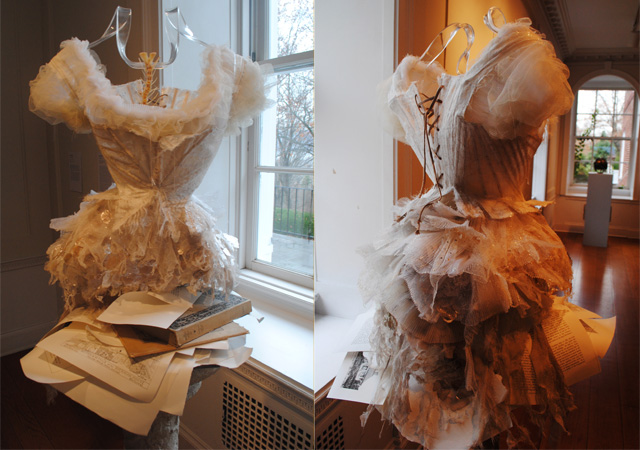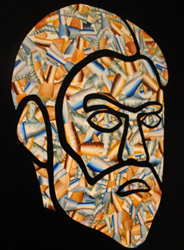Tandem Pursuits: Armor & Ichthyology
By Alison Greaney
The Glyndor Gallery at Wave Hill was home to medieval armor and aquatic creatures for the fall art exhibition, Tandem Pursuits: Armor and Ichthyology. This unlikely combination was inspired by the extraordinary Bronx resident Bashford Dean (1867-1928).
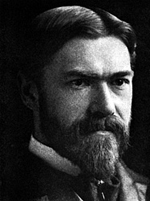
Bashford Dean
Dean was the curator of fish and reptiles at the American Museum of Natural History in 1912, at the start of his residence at Wave Hill. He then became the first Curator of Arms and Armor at the Metropolitan Museum of Art. Dean lived in Wave Hill House from 1909 to his death in 1928. This exhibit pays tribute to his life and myriad fascinations.
Dean’s passion for both fish and armor served as the catalyst for the exhibition. The contemporary artwork on display represents theories of adaptation, pattern and defense that so fascinated Dean. The works of 16 artists comprise this interesting variety of pieces.
One piece that combines Dean’s interests in fish and armor is WonJung Choi’s “Fearless”, 2013. The installation consists of nine hanging fish constructed from antique armor, silverware, and chainmail; the metal appears to serve as armor for the fish.
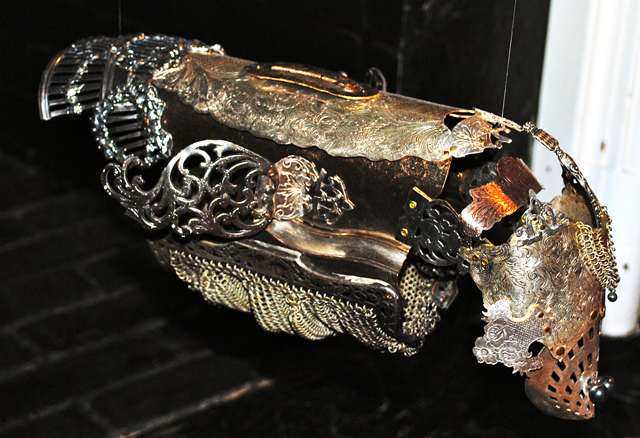
WonJung Choi, “Fearless,” 2013
The artist Camilla Huey created a sculptural portrait of Dean’s wife, “Mary Alice Dyckman Dean,” 2013. The piece consists of a fabric corset atop papers from books and letters depicting Mrs. Dean’s immersion in historical research.
Her husband is intertwined in the piece through the fishbone tail emerging from the lacy neck.
The artist Ben Snead created a portrait, “Bashford Dean,” 2013 for the exhibit. In the painting he collaged images of catfish behind a stern outline of Dean’s face. Catfish were incorporated into this piece because they were the subject of Dean’s doctoral thesis.
Bashford Dean life’s work, the study of both fish and armor, is in keeping with the primary purpose of Wave Hill, which is to connect people to nature through culture. The exhibit “Tandem Pursuits” exemplifies this principle in its celebration of artist’s use of armorial and ichthyologic motifs.
The artist Irvin Morazan blends ancient symbolism and modern popular culture to create dialogue between past and present. “Object for Cutting Through Space and Time,” a headdress made for this exhibition, incorporates designs reminiscent of fish and traditional armor.
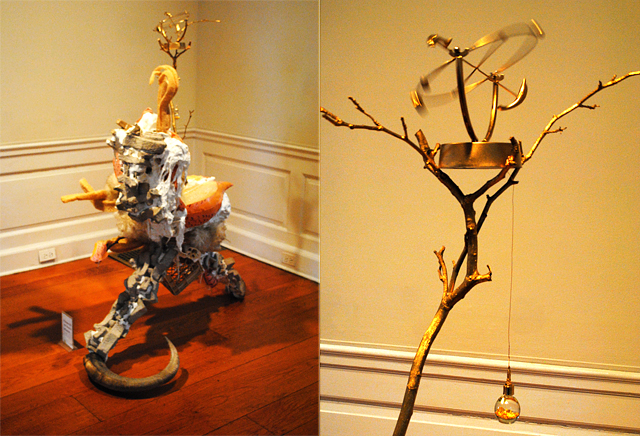
Irvin Morazan, “Object for Cutting Through Space and Time,” close-up of top on the right
In “Bashford Dean Portrait,” Camilla Huey assembled a jacket inspired by Japanese karuta kotes, padded coats covered with chain mail and lacquered leather that samurais wore beneath their armor. Referring to Dean’s ichthyologic accomplishments, the jacket is framed by a satin representation of oversize embryonic pectoral bones with fins that reach to the floor.

Camilla Huey , “Bashford Dean Portrait,” 2013 (l), Carol Hepper, “Percussion,” 2000 (r).
The artist Carol Hepper used fish skin to create Percussion in 2000. It is made from the skins of a sturgeon, an armored fish with large bony plates instead of scales. The effect of light passing through these painted skins brings out the beauty of this natural armor.

In the process of making these fish lamps the artist, Frank Gehry, got an appreciation for the form and iconographic power of fish.

“Cardboard Bottom Fishes: Himantolophus groenlandicus, Photocorynus spiniceps, Lasiognathus saccostoma, Linophryne arborifera and Melanocetus niger,” 1983.
In her “Cardboard Bottom Fishes,” artist Christy Rupp draws a connection between degradation and the politicians behind the environmentally detrimental policies enacted under President Ronald Reagan. The unsightly bottom fishes are suppose to illustrate these public figures.
Kymia Nawabi’s “The Soul Purpose” piece depicts a burial ceremony in which a group of female figures-part animal, part human and part deity- gather. Their airily painted feet and legs show that they are celestial, but also grounded in earthly conceptions of strength and resilience.

Kymia Nawabi, “The Soul Purpose,” 2011
Michelle Jaffe’s sculptures investigate the visual language of clothing. This series, Cod Variations, riffs on the medieval codpiece, a common addition to suits of armor. As with the medieval armor that Bashford Dean admired, these seamlessly constructed aluminum pieces are elegant.

Michelle Jaffe, “Cod Variations: Equus,” 2007
Saved under Culture, Featured Slide

